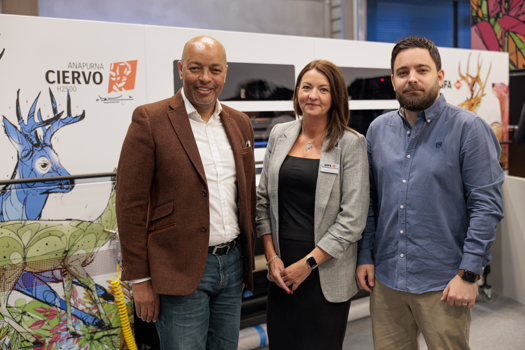Down, but by no means out, is how upbeat PA chief executive Richard Mollet weighs up the current market for printed books. Right now, he’s thumbing the 104 pages of his association’s recently published Statistics Year Book, a less salacious read than EL James’ erotic trilogy, but every bit as compelling.
Fifty Shades of Grey and its sequels helped ring up monster sales of both printed and electronic books last year contributing to a rise in total physical and digital book sales of 4% to £3.3bn, against a 2% drop in 2011. Almost as telling, Mollet says, is that the relentless, onward march of e-books has barely touched the sale of printed books.
Printed books still account for the vast majority of sales, slipping by only 1% to £2.9bn last year. This confounds the doomsday mongers who continually predicted a faster, steeper demise of the printed book, according to Mollet.
"What jumps out most is the 4% increase across the board, which is a strong performance, especially when you look at the economy and the havoc digital has played with some of the revenue streams of other creative industries," Mollet says. "Publishing seems to have fought well and shown a healthy reaction."
Such ‘standout’ blockbuster fiction as the Fifty Shades series is only part of the success story of books in general and print in particular, Mollet believes, citing past fillips from the Harry Potter books and the Stieg Larsson novels. He is keen to credit this latest sales spike not solely to the literary prowess of EL James, who sold more than 10m copies.
A 2% rise in sales of hardback fiction "underlines the fact there are some areas within the physical realm that are particularly popular". Also popular in touchy-feely form are children’s and school books, both of which boast around 95% sales, while 84% of all academic and professional tomes roll off printing presses rather than the digital screen.
Other notable statistics from the year book include an increase of 4% for the home physical sales of children’s books, up to £233m, while home physical sales of school books saw a rise of 6%, to £172m. Total physical sales of fiction books have also grown, by 3% in 2012, leading to sales of £502m.
Tablet onslaught
Wincanton Print company secretary Tania Graham is not so buoyed up by these latest figures though: "I am very surprised the fall in sales of printed books last year was a mere 1% because I can see the fall that we’ve had in the market. I’m surprised the drop was not much higher, given the onslaught of tablet technology."
But Graham, based in Somerset, is content to play the waiting game: "I think people are getting bored by some of the technology. From my own experience with children and grandchildren, much technology is a novelty that soon wears off. I would like to think that print can stage a fight-back. There are some areas, such as colour accuracy and paper, where people still want and value good quality."
Where self-publishing fits into the mix is another grey area neither Graham nor Mollet can fathom in terms of impact on print. Both avoid drawing too strong a link between the trend that launched EL James on to an unsuspecting public and print fortunes. But what it has done is to flag up and then fast-track raw talent from online backwater to publishing mainstream. And that, they say, can only be good.
Some of this new talent has found its way to Berforts Information Press in Stevenage, Hertfordshire. The litho and digital printer has notched up notable successes from self-publishers such as one author who sold 1,500 books on a village history and others who have shifted anywhere between 50 and 700 books.
Sales and marketing manager Dale Burgess says he is not surprised about the findings in the PA Statistics Year Book: "The effect of e-books was inevitable, but what’s surprising is the type of books doing well in print. Paperbacks used to be most common to meet demand for cheap, cheerful and minimum cost.
"But that’s been turned on its head. We are getting more hardback orders and because there aren’t so many hardback printers around, we are picking up a bit of work. A couple of big companies have stopped offering sewing as a service and we are one of the few book printers that now offer sewing, so that helps."
Berforts’ key to success, claims Burgess, is to "keep chomping away – look for new work, talk to the right people, keep in the loop and offer the right service". Berforts’ splits its work between the UK and a partner in the US. Burgess says books printers must embrace continual reinvention but also continuity. "My team kept sewing and craft binding skills while others got rid of them," he says.
Such a positive vibe chimes with Mollet who draws at least one conclusion with no grey areas: "Don’t assume digital will kill printed nooks, which people have said for a long time. The music industry shows it can perform with digital, and physical books are got going away any time soon. There will always be a role for book printers."
OPINION
The permanence of books will ensure their longevity
 Francis Atterbury, partner, Hurtwood Press
Francis Atterbury, partner, Hurtwood Press
I’m not really surprised that the fall in sales of printed books was only 1%; the only surprise was, perhaps, that others were surprised. Why do people constantly write off a technology that has been doing a perfectly good job for more than 500 years?
Digital technology merely increases the numbers of copies out there. I know plenty of people who have music on both CDs and digital format. And while the future of CDs may be uncertain, I cannot see books disappearing for the simple reason they are an extremely good way of imparting information, if not the best.
Take academic books: print media is extremely cumbersome to pirate and is therefore a much more secure way of delivering information. Digital words, meanwhile, can disappear around the world at the press of a button. Print is unalterable, a huge boon to academic publishers where reputations stand or fall on accuracy; plus you can write in the margins of books, a pure delight to academics.
That’s not to say there won’t be change. Run lengths will probably decline and people will start to value more personalisation, but longevity in other areas cannot be disputed. You can still open the Domesday Book from 1086, whereas you can’t open a floppy disk from 1986. Print probably won’t enjoy the massive growth of 1895, but there won’t be a revolution anytime soon.
Danger lurks closer to home, however. Forget the bright young things pushing digital boundaries, the sad truth is the quality of printed books can be diabolical and it’s a bit rich complaining about cheaper imports from South East Asia when books from China are often better made than those made here.
One of the key selling points of printed books is their quality, beauty and permanence, and printers forget this at their peril.
READER REACTION
Do the PA figures reflect the true health of the books sector?
 Kate McFarlan, managing director, Clays
Kate McFarlan, managing director, Clays
"No surprise with the findings; we knew last year’s figures were skewed by Fifty Shades and while it is a truism in publishing that every year there’s something new, Fifty Shades was a bit more than something. We have seen the decline in volumes slow down and it’s clear there’s a lot more stability of thought, optimism and focus across the sector. Average book print quantities have come down and will continue to do so, but the number of orders has gone up. We don’t see that trend changing in the near future." Alison Kaye, group sales director, CPI Books
Alison Kaye, group sales director, CPI Books
"We see positive aspects to the Publishers Association figures, but the Fifty Shades phenomenon, which benefited CPI hugely last year, masks trends. The trend to print little and often continues; 2012 fitted our strategy of ‘one to 1m books’ thanks to technology for any run length. We’re pleased to see a growth in colour books in the figures, which chimes with our experience, and children’s and cookery books are resilient. It is often thought cannibalisation of print by e-books will reach a plateau – could we be reaching that point?" Jon Sole, manufacturing director, TJ International
Jon Sole, manufacturing director, TJ International
"I’m not surprised with the figures; we’ve had a stable period and the mood at the International Book Fair in London was more buoyant than it has been for the past two years. We are seeing more smaller, niche-type publishers emerging. It’s still tough, especially for paperbacks, but the growth of electronic books seems to have leveled out. I think people are getting bored of the technology, whereas quality-book publishers are giving more added value because they realise they have a product."










